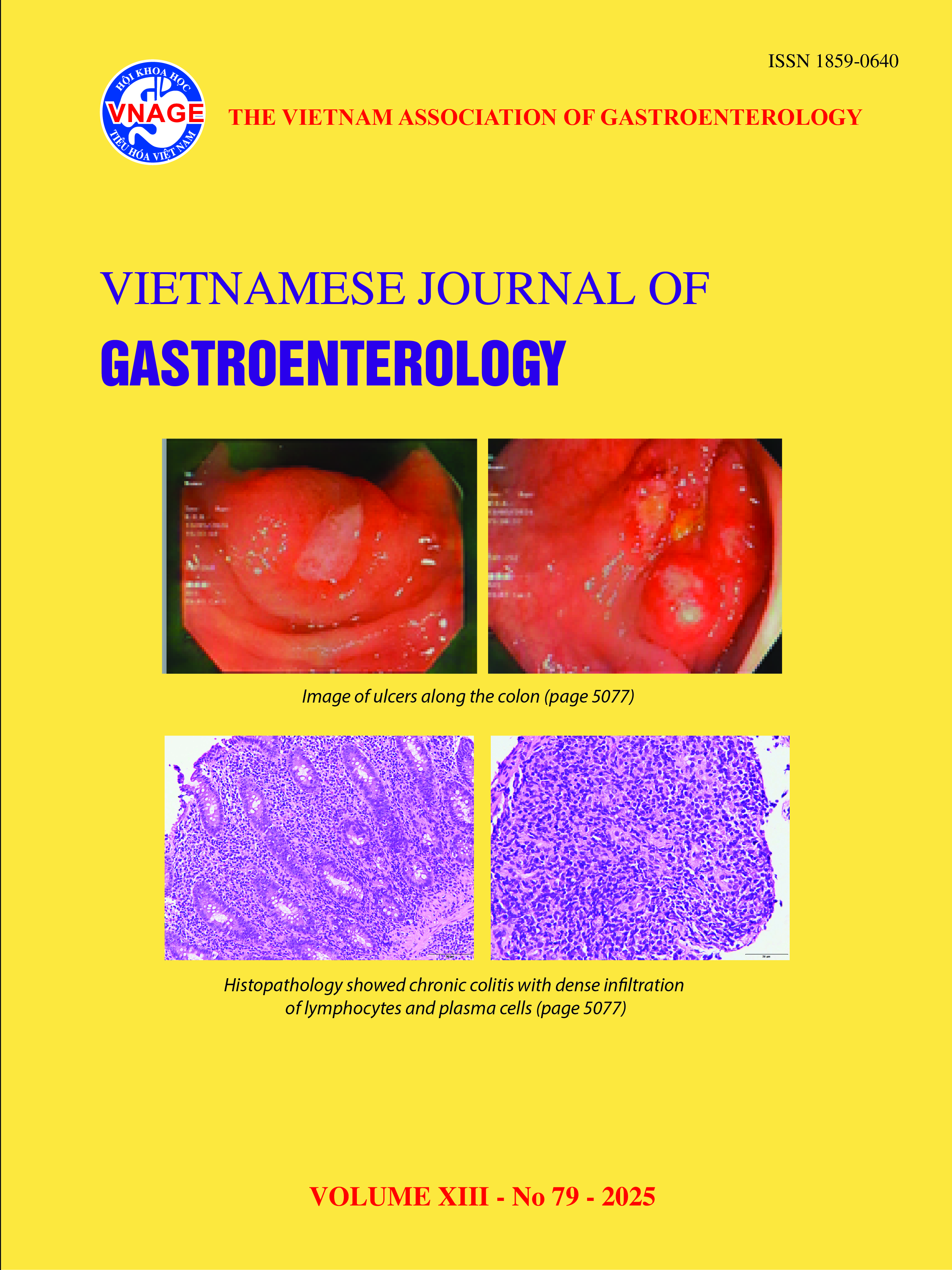Primary antibiotic resistance of helicobacter pylori in vietnamese patients with peptic ulcer disease
DOI:
https://doi.org/10.63583/r2we5m74Từ khóa:
Primary antibiotic resistance, Cag A, VacA,CYP2C19, H.pylori, peptic ulcer diseaseTóm tắt
Background: Helicobacter pylori is a group 1 carcinogen. The genes cagA and vacA are the most studied, as they are crucial virulence factors linked to the pathogenicity of this bacterium. Antibiotic resistance is the main cause of failure in H.pylori eradication. Updating the antibiotic resistance situation of H.pylori in each region is important for recommending appropriate treatment regimens for the population and optimizing the effectiveness of H.pylori eradication treatment for each region and country. In addition, the polymorphism of the enzyme CYP2C19 alters the metabolism of proton pump inhibitors (PPIs), thereby affecting treatment outcomes in patients with peptic ulcer disease (PUD) and the eradication of H.pylori. Objective: To determine the rate of primary antibiotic resistance of H.pylori strains to Amoxicillin (AMX), Clarithromycin (CLA), Levofloxacin (LEV), Metronidazole (MET), and Tetracycline (TET) and investigate the prevalence of H.pylori virulence factors cagA, vacA and the phenotypes of CYP2C19 enzyme polymorphism. Subject and method: A cross-sectional descriptive study was performed on 216 patients at the American International Hospital from October 2019 to September 2022.Patients with peptic ulcer disease who underwent endoscopy and antibiotic culture by Epsilometer test (E-test) and the cagA, vacA genes, and CYP2C19 enzyme-encoding genes were identified using PCR techniques. Result: Among 216 patients, the mean age was 42.85 ± 11.76. The rate of primary resistance to CLA was the highest at 96.30%, while the rates of resistance to LEV, MET, and AMX were 58.8%, 8.80%, and 2.78%, respectively. In the study, there were no cases of primary antibiotic resistance to Tetracycline, with a resistance rate of 0%. There was no statistically significant difference in the rate of resistance to each antibiotic between the male and female groups (p>0.05). The rate of dual resistance to two antibiotics was very high, with 161/216 cases (74.54%). H.pylori strains with CagA (+) virulence factor accounted for 72.69%, while CagA (-) strains accounted for 27.31%. There was no significant gender difference in CagA distribution (p=0.488). All patients with peptic ulcer disease harbored H.pylori strains with VacA virulence, with the s1m1 type being the most common (50%). Patients with intermediate CYP2C19 metabolism phenotypes had the highest prevalence at 49.07%, followed by strong metabolizers (39.35%) and poor metabolizers (11.58%). There was no significant difference in CYP2C19 enzyme metabolism phenotypes between males and females (p=0.454). Conclusion: The very high rate of resistance to Clarithromycin indicates that the standard triple regimen is no longer effective and should not be used in clinical practice. The regimen with Levofloxacin should be combined with Bismuth to enhance treatment effectiveness. The rates of resistance to Amoxicillin, Tetracycline, and Metronidazole were low, so a Bismuth quadruple or a combination of these three drugs may be very effective in eradicating H.pylori. In untreated patients with H.pylori -induced peptic ulcer disease, CagA (+) genotype and VacA s1m1 genotype were predominant. These strains are associated with more severe tissue damage and higher activity levels compared to others. Patients with intermediate and strong CYP2C19 metabolizer phenotypes were relatively common. These patients may experience altered metabolism of proton pump inhibitors, which could impact treatment outcomes for peptic ulcer disease and H.pylori eradication.
Tài liệu tham khảo
1. Hooi JKY, Lai WY, Ng WK, et al. Global Prevalence of Helicobacter pylori Infection: Systematic Review and Meta-Analysis. Gastroenterology. Aug 2017;153(2):420-429.
2. Humans IWGotEoCRt. Biological agents. Volume 100 B. A review of human carcinogens. IARC Monogr Eval Carcinog Risks Hum. 2012;100(Pt B):1-441.
3. Yamaoka Y. Pathogenesis of Helicobacter pylori-Related Gastroduodenal Diseases from Molecular Epidemiological Studies. Gastroenterology research and practice. 2012;2012:371503.
4. Goldstein JA, de Morais SM. Biochemistry and molecular biology of the human CYP2C subfamily. Pharmacogenetics. Dec 1994;4(6):285-99. doi:10.1097/00008571-199412000-00001
5. Khien VV, Thang DM, Hai TM, et al. Management of Antibiotic-Resistant Helicobacter pylori Infection: Perspectives from Vietnam. Gut and liver. Sep 15 2019;13(5):483-497.
6. Baradaran A, Dehghanbanadaki H, Naderpour S, et al. The association between Helicobacter pylori and obesity: a systematic review and meta-analysis of case–control studies. Clinical Diabetes and Endocrinology. 2021/07/10 2021;7(1):15.
7. Binh TT, Shiota S, Nguyen LT, et al. The incidence of primary antibiotic resistance of Helicobacter pylori in Vietnam. Journal of clinical gastroenterology. Mar 2013;47(3):233-8. doi:10.1097/MCG.0b013e3182676e2b
8. Phan Trung Nam, Tran Van Huy, Tran Thi Nhu Hoa, Le Van An A, Santona BP, Rubino S. Antibiotic resistance of Helicobacter pylori in the Central region from 2012 to 2013 using the E-test method. Vietnam Journal of Gastroenterology. 2013;VIII(33).2122-2132.
9. Quek C, Pham ST, Tran KT, et al. Antimicrobial susceptibility and clarithromycin resistance patterns of Helicobacter pylori clinical isolates in Vietnam. F1000Res. 2016;5:671-671.
10. Dinh Quy Hue. Study on the resistance rates of Helicobacter pylori to clarithromycin and levofloxacin using the epsilometer and the efficacy of the EBMT regimen in patients with chronic gastritis. 2018.
11. Shiota S, Reddy R, Alsarraj A, El-Serag HB, Graham DY. Antibiotic Resistance of Helicobacter pylori Among Male United States Veterans. Clinical gastroenterology and hepatology : the official clinical practice journal of the American Gastroenterological Association. Sep 2015;13(9):1616-24.
12. Kuo YT, Liou JM, El-Omar EM, et al. Primary antibiotic resistance in Helicobacter pylori in the Asia-Pacific region: a systematic review and meta-analysis. The lancet Gastroenterology & hepatology. Oct 2017;2(10):707-715.
13. Bachir M, Allem R, Tifrit A, et al. Primary antibiotic resistance and its relationship with cagA and vacA genes in Helicobacter pylori isolates from Algerian patients. 10.1016/j.bjm.2017.11.003. Brazilian Journal of Microbiology. 2018;49(3):544-551.
14. Wang D, Guo Q, Yuan Y, Gong Y. The antibiotic resistance of Helicobacter pylori to five antibiotics and influencing factors in an area of China with a high risk of gastric cancer. BMC microbiology. 2019/07/04 2019;19(1):152.
15. Palmitessa V, Monno R, Panarese A, et al. Evaluation of Antibiotic Resistance of Helicobacter pylori Strains Isolated in Bari, Southern Italy, in 2017-2018 by Phenotypic and Genotyping Methods. Microbial drug resistance (Larchmont, NY). Aug 2020;26(8):909-917.
16. Savoldi A, Carrara E, Graham DY, Conti M, Tacconelli E. Prevalence of Antibiotic Resistance in Helicobacter pylori: A Systematic Review and Meta-analysis in World Health Organization Regions. Gastroenterology. Nov 2018;155(5):1372-1382.e17.
17. Malfertheiner P, Megraud F, Rokkas T, et al. Management of Helicobacter pylori infection: the Maastricht VI/Florence consensus report. Gut. Aug 8 2022;doi:10.1136/gutjnl-2022-327745
18. Thai Thi Hong Nhung, Hoa NT. Study on the Prevalence of CagA Gene Carriage in Helicobacter pylori and Its Association with Gastric and Duodenal Diseases. Can Tho Journal of Medicine and Pharmacy. 2023;36(67):13-19.
19. Chan Thien Trung, Nguyen Tuan Anh. Results of CagA and VacA Gene Research of Helicobacter pylori in Gastritis Patients Using Multiplex PCR Method. Vietnam Journal of Gastroenterology Science. 2013;VIII(Issue 33):2102-2108.
20. Hussein NR, Mohammadi M, Talebkhan Y, et al. Differences in virulence markers between Helicobacter pylori strains from Iraq and those from Iran: potential importance of regional differences in H.pylori-associated disease. Journal of clinical microbiology. May 2008;46(5):1774-9. doi:10.1128/jcm.01737-07
21. Kishk RM, Soliman NM, Anani MM, et al. Genotyping of Helicobacter pylori Virulence Genes cagA and vacA: Regional and National Study. International journal of microbiology. 2021;2021:5540560. doi:10.1155/2021/5540560
22. Ito Y, Azuma T, Ito S, et al. Analysis and typing of the vacA gene from cagA-positive strains of Helicobacter pylori isolated in Japan. Journal of clinical microbiology. Jul 1997;35(7):1710-4. doi:10.1128/jcm.35.7.1710-1714.1997
23. Bachir M, Allem R, Tifrit A, et al. Primary antibiotic resistance and its relationship with cagA and vacA genes in Helicobacter pylori isolates from Algerian patients. Brazilian journal of microbiology : [publication of the Brazilian Society for Microbiology]. Jul-Sep 2018;49(3):544-551. doi:10.1016/j.bjm.2017.11.003
24. Memon AA, Hussein NR, Miendje Deyi VY, Burette A, Atherton JC. Vacuolating cytotoxin genotypes are strong markers of gastric cancer and duodenal ulcer-associated Helicobacter pylori strains: a matched case-control study. Journal of clinical microbiology. Aug 2014;52(8):2984-9. doi:10.1128/jcm.00551-14
25. Backert S, Blaser MJ. The Role of CagA in the Gastric Biology of Helicobacter pylori. Cancer research. Jul 15 2016;76(14):4028-31. doi:10.1158/0008-5472.Can-16-1680
26. Le QH and Ha TMT. Determination of Helicobacter Pylori Caga Gene and Vaca Genotypes in Patients with Gastric Cancer. Journal of Medicine and Pharmacy. 2013:118-125.
27. Morales-Espinosa R, Castillo-Rojas G, Gonzalez-Valencia G, et al. Colonization of Mexican patients by multiple Helicobacter pylori strains with different vacA and cagA genotypes. Journal of clinical microbiology. Sep 1999;37(9):3001-4. doi:10.1128/jcm.37.9.3001-3004.1999
28. Atherton JC, Cao P, Peek RM, Jr., Tummuru MK, Blaser MJ, Cover TL. Mosaicism in vacuolating cytotoxin alleles of Helicobacter pylori. Association of specific vacA types with cytotoxin production and peptic ulceration. The Journal of biological chemistry. Jul 28 1995;270(30):17771-7. doi:10.1074/jbc.270.30.17771
29. Tran Ngoc Luu Phuong, Pham Hung Van. Polymorphism of CYP2C19 Enzyme in Vietnamese Patients with H.pylori-induced Peptic Ulcer Disease After Treatment. . Vietnam Journal of Gastroenterology Science 2014;IX(37):2391-2399.
30. Tassaneeyakul W, Mahatthanatrakul W, Niwatananun K, et al. CYP2C19 genetic polymorphism in Thai, Burmese and Karen populations. Drug metabolism and pharmacokinetics. Aug 2006;21(4):286-90. doi:10.2133/dmpk.21.286
31. Alrajeh KY, Roman YM. The frequency of major CYP2C19 genetic polymorphisms in women of Asian, Native Hawaiian and Pacific Islander subgroups. Personalized medicine. Jul 2022;19(4):327-339. doi:10.2217/pme-2021-0175
32. Phan Trung Nam. Study of the CYP2C19 gene polymorphism and its association with the efficacy of high-dose dual therapy (PPI, amoxicillin) for Helicobacter pylori. Journal of Clinical Medicine - Hue Central Hospital. 2023;85
33. He L, Chen S, Li J, et al. Genetic and phenotypic frequency distribution of CYP2C9, CYP2C19 and CYP2D6 in over 3200 Han Chinese. Clinical and experimental pharmacology & physiology. Oct 2020;47(10):1659-1663. doi:10.1111/1440-1681.13357
34. Sukprasong R, Chuwongwattana S, Koomdee N, et al. Allele frequencies of single nucleotide polymorphisms of clinically important drug-metabolizing enzymes CYP2C9, CYP2C19, and CYP3A4 in a Thai population. Scientific reports. Jun 11 2021;11(1):12343. doi:10.1038/s41598-021-90969-y
35. El Rouby N, Lima JJ, Johnson JA. Proton pump inhibitors: from CYP2C19 pharmacogenetics to precision medicine. Expert opinion on drug metabolism & toxicology. Apr 2018;14(4):447-460. doi:10.1080/17425255.2018.1461835









